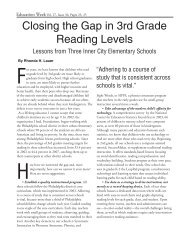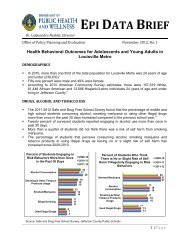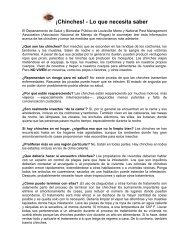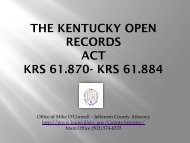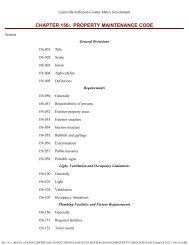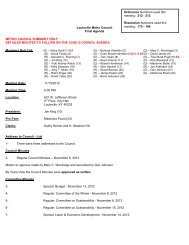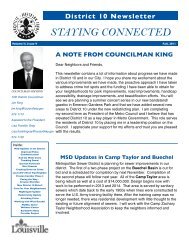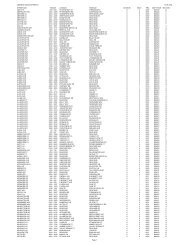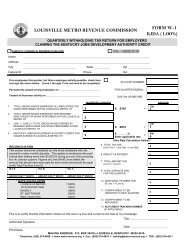Cultural History of Charlie Vettiner Park - Louisville Metro Government
Cultural History of Charlie Vettiner Park - Louisville Metro Government
Cultural History of Charlie Vettiner Park - Louisville Metro Government
You also want an ePaper? Increase the reach of your titles
YUMPU automatically turns print PDFs into web optimized ePapers that Google loves.
<strong>Cultural</strong> <strong>History</strong> <strong>of</strong> <strong>Charlie</strong> <strong>Vettiner</strong> <strong>Park</strong><br />
shales, and older alluvium on the uplands plains. Glacial outwash and glacial drift are additional<br />
parent materials in the northern part <strong>of</strong> this region.<br />
Soils within the project area are contained within the Beasley-Fairmount-Russellville Association<br />
(Zimmerman 1966:6). Soils <strong>of</strong> this association occupy gently sloping to sloping hillsides and<br />
strongly sloping, steep hillsides over limestone. Beasley silt loam series soils account for about<br />
45 percent <strong>of</strong> the association. These soils are deep and well drained (Zimmerman 1966:7).<br />
They typically have a surface layer <strong>of</strong> brown silt loam with a yellowish brown silty clay subsoil.<br />
Excellent agricultural soils are found within this association in the valley <strong>of</strong> Floyd‘s Fork. For this<br />
reason, large farms (between 120-180 acres in 1966) are located within areas <strong>of</strong> this soil<br />
association. Development has been slow to come to this part <strong>of</strong> the county. However, more<br />
recently, upscale residential subdivisions have been sited in the area.<br />
The local soils developed from limestone and calcareous shale bedrock as well as wind-blown<br />
loess additions (Zimmerman 1966). All had been in agricultural use until landuse changed to<br />
park status. Due to this landuse and the hilly terrain, some series have been eroded down to<br />
subsoil. Soils mapped for the parks are shown in Figure 5 and summarized in Table 1. Soils in<br />
the majority <strong>of</strong> the park conform to the Crider silt loam. Nicholson silt loam developed upslope <strong>of</strong><br />
the Crider; Beasley, Shrouts, and Faywood soils are located downslope.<br />
Figure 5. Soils mapped for <strong>Charlie</strong> <strong>Vettiner</strong> <strong>Park</strong> (NRCS 2008).<br />
8 | P a g e



